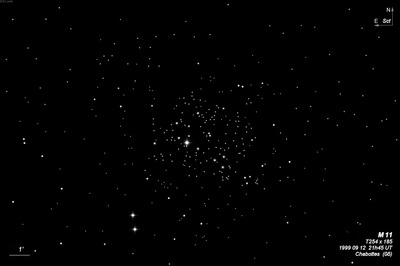Amas de l'Ecu de Sobieski,Wild Duck Cluster
Amas de l'Ecu de Sobieski,Wild Duck Cluster

Gottfried Kirch discovered M11 = NGC 6705 = h2019 on 1 Sep 1681 in Leipzig, Germany and made a rough sketch (the bright mag 8 star is prominently drawn but no other stars). William Derham first resolved it around 1733 with an 8-foot (focal length) reflector and described "..not a nebulose, but a cluster of stars, somewhat like that which is in the Milky Way" (PT XXXVIII, 70). De Chéseaux also resolved it into "a wonderful cluster of small stars."
WH observe the cluster with his 10-ft telescope (4-inch aperture) around 1780 and noted the cluster was visible naked-eye. JH wrote (23 Jul 1827), "A beautiful irregularly R cl 10' or 12' diam. The stars are all 11m except one = 9m whose place is taken. Examined with high magnifiers [I have often viewed it with 800 and even 1200]; it is broken into 5 or 6 distinct groups with rifts or cracks between them." Observing with a 9.5" refractor around 1856, Father Secchi described the cluster as having three leaf-shaped dark lanes (AN 43, 157).
The nickname "Wild Duck Cluster" is from Admiral Smyth's 1844 guidebook "A Cycle of Celestial Objects". He describes the telescopic appearance as "A splendid cluster of stars ...which somewhat resembles a flight of wild ducks in shape, is a gathering of minute stars, with a prominent 8th-magnitude in the middle, and two following".
200/250mm - 8" (7/16/82): this is the most impressive open cluster with this aperture. Appears as an extremely rich carpet of faint stars and dense clumps in an arrowhead shape.
300/350mm - 13.1" (7/16/82): at 140x, several hundred stars mag 11-15 and a brighter mag 8 star (SAO 142695) in a 10' region form a remarkably rich cluster including some dense knots of stars. A starless vacuity is visible just west of center at medium power. Dark lanes appear to wind through the cluster at high power grouping the stars into chains. Several dark nebula are near including B108, B112, B318.
Notes by Steve Gottlieb